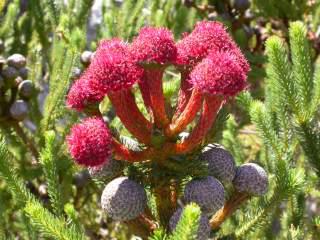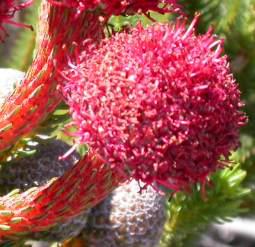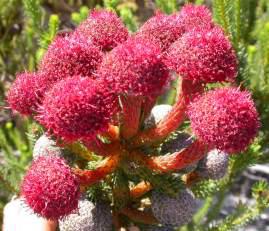Berzelia stokoei
Berzelia stokoei (E.Phillips) A.V.Hall
Family: Bruniaceae
Common names: red kolkol (Eng.); rooistompie (Afr.)
Introduction
The striking red flowers of Berzelia stokoei are a sight to behold when walking in the tranquil mountains of the Overberg region. This plant was previously called Brunia stokoei.

Description
Description
Berzelia stokoei is an upright, resprouting shrub, which grows to a height of 2 m. It has a similar growth habit to B. albiflora. However, the needle-like leaves are glabrous (smooth), stalkless, 8-10 mm long and have an evident midvein underneath.

The red flowers are borne in flower heads of 15 mm across during summer, from November to April.

Conservation Status
Status
Not threatened.
Distribution and habitat
Distribution description
Berzelia stokoei occurs from the Hottentots Holland Mountains to Kleinmond, but is prevalent in the rocky sandstone mid slopes of the Betty's Bay and Kleinmond areas and is endemic to the Western Cape.
Derivation of name and historical aspects
History
The genus Brunia was named after Dr Cornelius Brun, who was a chemist and plant collector and Carl Linnaeus' contemporary. The species stokoei is named after a very important collector of fynbos plants, Thomas Pearson Stokoe who died at the age of 91.
Ecology
Ecology
TheTrichostetha fascicularis green protea beetle and sunbirds are known to frequent this plant when in flower.
Uses
Use
Due to its striking red flowers, Berzelia stokoei is used in the cut-flower industry, but not as much as B. albiflora.

Growing Berzelia stokoei
Grow
Berzelia stokoei can be grown from seed as well as vegetatively (cuttings). Brunia stokoei is serotinous, the seed heads stay on the parent plant for more than one season and can withstand fires; because of this it is best to collect seeds from flower heads that are at least 2-3 years (seasons) old.
For best germination results treat seeds with the Kirstenbosch Instant Smoke Plus Seed Primer. Sow seeds in a well-drained acidic medium and cover with a thin layer of soil. Feed seedlings with Kelpak, a seaweed-based fertilizer, to strengthen the roots.
Take cuttings from healthy, actively growing shoots. Dip the cuttings in a rooting hormone and place into a rooting medium suited for fynbos plants. Cuttings can be placed on heating benches or in a warm, well-ventilated space. This will improve rooting. Keep the cuttings moist and do not allow them to dry out. Once rooted, plant into individual plant bags or pots and feed with an organic fertilizer. Keep plants in a well-ventilated area but out of direct sunlight until they have acclimatized to the environment.
References
- Bean, A. & Johns, A. 2005. Stellenbosch to Hermanus. South African Wild Flower Guide 5, edn 2. Botanical Society of South Africa, Cape Town.
- Goldblatt, P. & Manning, J. 2000. Cape plants. A conspectus of the Cape flora of South Africa. Strelitzia 9. National Botanical Institute, Pretoria & Missouri Botanical Garden.
- Jackson, W.P.U. 1990. Origins and meanings of names of South African plant genera. University of Cape Town Printing Department.
- Picker, M., Griffiths, C. & Weaving, A. 2002. Field guide to insects of South Africa. Struik, Cape Town.
- Smith, C.A. 1966. Common names of South African plants. Memoirs of the Botanical Survey of South Africa No. 35.
Credits
Berenice Carolus
Harold Porter National Botanical Garden
August 2007
Plant Attributes:
Plant Type: Shrub
SA Distribution: Western Cape
Soil type: Sandy
Flowering season: Early Summer, Late Summer
PH: Acid
Flower colour: Red
Aspect: Full Sun
Gardening skill: Average
Special Features:
Horticultural zones







Rate this article
Article well written and informative
Rate this plant
Is this an interesting plant?
Login to add your Comment
Back to topNot registered yet? Click here to register.